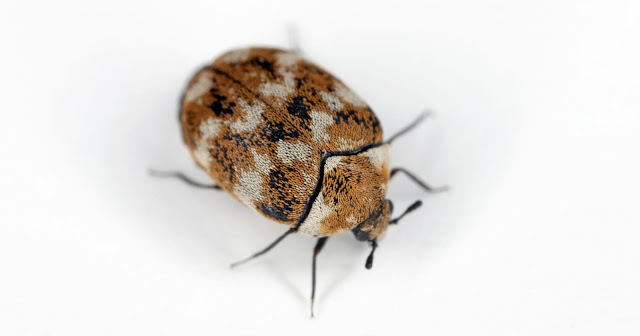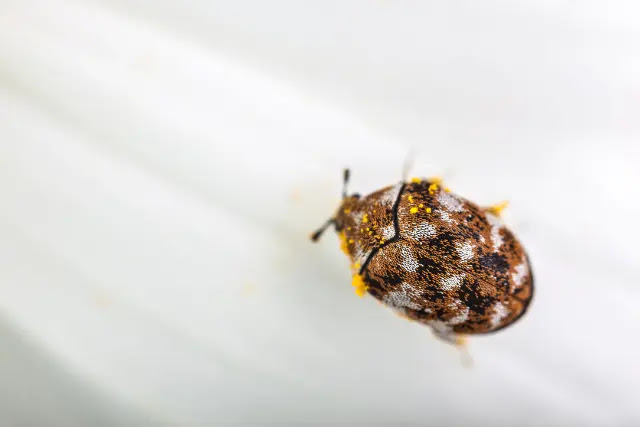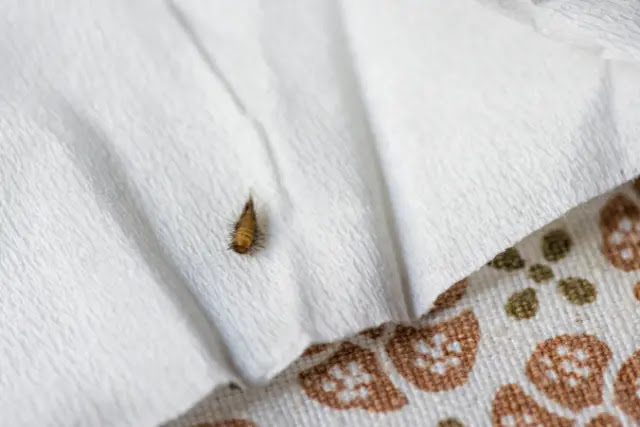Have you ever seen carpet beetles when late spring or early summer comes around? These small bugs, both adults and larvae, can indeed leave marks on your skin that look like bed bug bites. They also can make holes in clothes, sheets, and carpets - so it's no wonder some people are asking if these creatures can get under our skin!
Carpet beetles don't get under your skin, but they do eat keratin, a type of protein that helps protect human and animal hair. That means if you have these little bugs in your house, they might be snacking on the hairs on your head or face, your armpits, or even along the length of your legs or groin.
They also love natural fibers like wool so if there are holes in any clothes made out of fabrics like this, particularly near seams and hemlines, then it could be because these munching pests were at work! But before you worry too much about them, read up to find out more information about carpet beetles.
{tocify} $title={Table of Contents}
What are carpet beetles?
Carpet beetles are small insects that belong to the family Dermestidae. They vary in size and color but typically range from 1/8 to 3/16 of an inch long and have a black, brown, or tan body with mottled yellow, white, or orange markings. Their bodies are oval-shaped and covered in scales or hairs which give them unique coloring and texture. The head features small eyespots as well as backward-facing bristles.
They come in a variety of shapes and sizes, making them difficult to identify. Carpet beetles live on windowsills, carpets, furniture, and clothes that are stored away. As babies they’re called larvae and look quite different from the adult beetle; they have bristles all over their bodies but are flat-shaped compared to the adults they become.
The larvae feed off fabrics or materials like fur, silk, or wool as their diet consists mainly of keratinous material. Then after some time without eating the larvae finds somewhere to hide so they can spin a silken cocoon around themselves for pupation – this is when it develops its wings and eventually becomes an adult beetle. Paying attention to warning signs is essential to identify if there could be a potential problem.
Do carpet beetles burrow in your skin?
There is a common myth regarding carpet beetles and human skin. Many people believe that these insects are capable of burrowing into human skin, which can be an alarming thought! However, this is not true. Carpet beetles cannot penetrate human skin or any other mammalian skin. While some insect species may burrow through our skin in some cases, carpet beetles are not one of them.
Don't be scared, carpet beetles are different from other pests like mites that cause itching. Carpet beetles have a body structure that does not allow them to penetrate the skin, unlike mites which contain toxins in their bodies. On top of that, carpet beetles require dry conditions (less than 35% moisture) found in carpets instead of human bodies which naturally contain more than 55%-70% moisture content. So you won't experience any piercing effects even though you come in contact with them!
To put it simply, carpet beetles do not burrow into human skin nor are they equipped to do so. The myth is nothing more than a scary story that people tell in an attempt to warn of the potential dangers of these insects. While there may be some household pests that pose health risks to humans, carpet beetles cannot penetrate our skin.
Are there allergic reactions caused by carpet beetles?
Carpet beetles and their larvae can cause skin reactions. While the adult carpet beetle does not live in human skin, its larvae may burrow into fabrics on beds or furniture when given the chance, leading to indirect contact with humans. Being exposed to these creatures can cause several minor allergic reactions. Most insects that come in contact with human skin cause varying degrees of irritation, anyway.
Symptoms of skin irritation or allergic reactions caused by carpet beetles often include itchy bumps, welts, redness, and inflammation. In some cases, the itching can be quite intense. Some individuals may experience an overwhelming urge to scratch the affected area to alleviate the discomfort caused by these irritating symptoms. However, prompt medical attention is recommended if more serious symptoms arise.
What are the symptoms of a carpet beetle infestation?
Carpet beetles can be an annoying pest as they feed on organic materials found in carpets and other fabrics, causing noticeable damage. Indicators of a carpet beetle infestation include damaged clothing or carpet fibers, especially near the seams or around buttons, or tiny insect droppings that look like pepper flakes scattered within the fabric fibers. In addition to this obvious physical damage caused by these pests, there may also be spots of skin irritation if someone is allergic to their saliva.
The most direct sign of a possible problem with carpet beetles is signs of physical damage present on clothing and furniture surfaces. Damage includes small holes in natural-fiber fabrics such as wool and silk. Carpet beetle larvae are often difficult to spot as they are very small but leaving dark fecal pellets along pathways created by moving through fabrics will also indicate their presence.
In more severe cases involving large infestations, people might feel what appears to be bites on their skin although carpet beetles do not bite or burrow into skin. This is because some people are allergic to carpet beetle saliva which leads to skin irritation and intense itching that could lead someone to assume they are bites.
How to prevent and treat carpet beetle infestations
Preventing and treating a carpet beetle infestation can be done through several methods, including regular cleaning and vacuuming. Carpet beetles feed on dead organisms such as leather, fur, hair, lint, pet dander, and other debris. Regularly dusting and vacuuming any areas near where they frequent can prevent them from getting out of hand. If you already have an outbreak of carpet beetles in your home or office area, it is best to address it as soon as possible with the proper treatment methods.
One way to treat a carpet beetle infestation is through the use of pesticides. There are several types available for purchase that may be used safely throughout your home or office building. Make sure to read all label instructions carefully before using any type of pesticide product inside your living space. Spraying along baseboards around windowsills and doorways will help keep away existing insects. You should never spray insecticide on items like bedding or clothing.
Another method to treat carpet beetle infestations is through heat treatments. These typically involve special equipment that heats the area to very high temperatures, killing off any existing carpet beetle larvae. Finally, if the infestation is extensive, professional exterminator services may need to intervene promptly before it gets worse. Professional fumigation services periodically assess your living space for any signs of a potential issue. They can give an expert opinion on how to best handle eradicating any existing issues while also providing preventative advice.
Conclusion
Don't worry, carpet beetles won't burrow into your skin. Even though they may feed on human hair in some cases, they don't penetrate the skin or cause any harm to people. These insects may be frightening due to their looks and behaviors, but with the right preventive measures you can reduce the risk of infestations greatly. To make sure that carpet beetles stay away from homes and businesses, it's important to know what attracts them.
That includes cleaning clothing that has been stored for a long time and removing sources of pollen from areas where carpet beetles may live. Vacuuming regularly also helps get rid of debris like fur or feathers which could attract them. By taking precautionary steps against beetle infestations, you can minimize your chances of having a problem with these pests at home or work.



